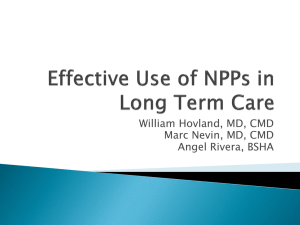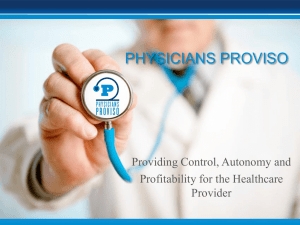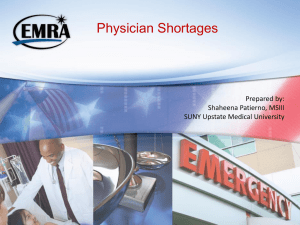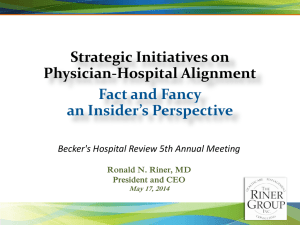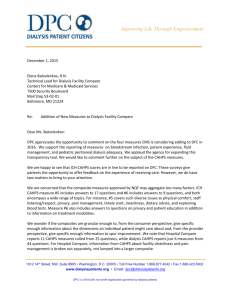Patient Experience and Relationship Centered Communication
advertisement
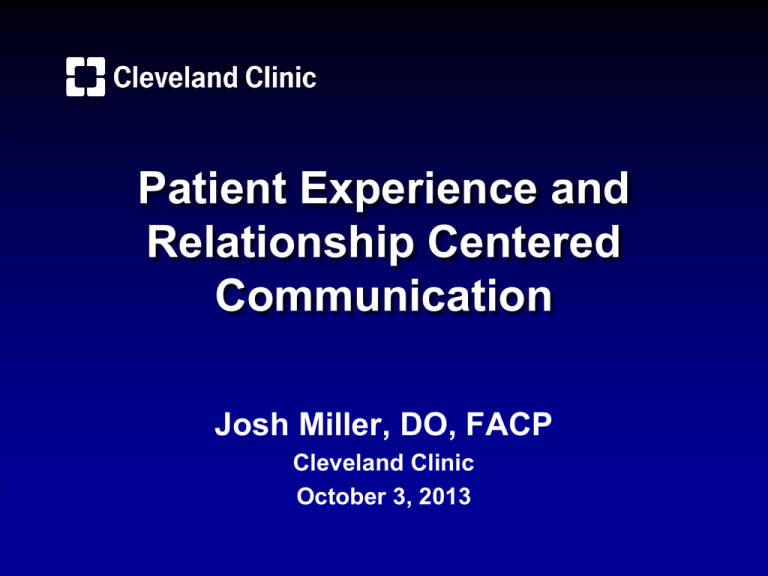
Patient Experience and Relationship Centered Communication Josh Miller, DO, FACP Cleveland Clinic October 3, 2013 “THESE PATIENT EXPERIENCE SCORES ARE BOGUS. I HAVE A WONDERFUL BEDSIDE MANNER!!” Picture of an angry doc. “Dr. X was rude and treated me like I was stupid. I actually cried in the office.” Today’s Objectives • Patient Experience and Healthcare Reform • The Clinical and Business effects of Patient Experience • Relationship Centered Communication improves patient and physician experience The National Picture • The Affordable Care Act Value = Quality / Cost • CMS uses the CAHPS surveys for standardization of patient experience What is CAHPS? Consumer Assessment of Healthcare Providers and Systems • Funded by U.S. Department of HHS • Promotes assessment of patients’ experiences with health care • Program Goals - Develop standardized surveys - Publicize & Compare results CAHPS Surveys Environment Survey Hospital HCAHPS Home Health HH-CAHPS Health Insurance Health Plan CAHPS In-Center Hemodialysis ICH CAHPS Nursing Home Nursing Home CAHPS Medical Practice CG-CAHPS CAHPS Background CMS CAHPS Goals Allow objective comparison on topics important to consumers Use public reporting to create an incentive to improve quality of care Enhance accountability by increasing transparency HCAHPS Hospital Consumer Assessment of Healthcare Providers & Systems • First national and standardized report of hospitalized patient experiences • Publically reported by Medicare in 2008 • Survey assessment areas: Doctor Communication Nurse Communication Pain Management Staff Response (Call light, bathroom) Medication Communication Discharge Communication Cleanliness Quiet at Night Hospital Rating Hospital Recommendation Value Based Purchasing Beginning in FY 2013, up to 1% of each hospital’s CMS acute care reimbursement at risk partially based on HCAHPS survey performance Transparency of Results • Hospital survey scores are published to Medicare’s hospital compare website and updated quarterly • Game Changer in 2008 • www.medicare.gov/hospitalcompare What’s Driving CG-CAHPS? Affordable Care Act Population Management Greater Transparency Greater Accountability A new model of health care delivery & financing Timeline for CG-CAHPS 2014 2015 2016 2017 • 2014- 2015 Practice level only • 2016 Pay for performance (proposed) • 2017 All physicians use CG-CAPHS CG CAHPS Survey Domains • Access to Care • Doctor • Front Desk • Coordination of Care Why should you improve your patient experience? Why Should We Pay Attention to Patient Experience? • Patient Experience: a component of certification and compensation - American Board of Medical Specialties MOC exams include core CG-CAHPS items - Private and public payers incorporating CGCAHPS into their compensation structures - Pay attention now or pay later RWJ Foundation; Good for Health, Good for Business, The case for Measuring Patient Experience 0f care Malpractice Litigation • 8% of docs account for over 85% of claim payouts • With every drop along a 5 point scale from very good to very poor, there is an increased likelihood of being named in a malpractice suit by 21.7% Fullam et al. Medical Care 47 (5) • The most important factor in predicting who will sue… The quality of the relationship between the patient and doctor Medical Economics, July 2003 The Clinical and Business Benefits of Patient Experience (PE) • A patient experience-centered practice is linked to lower physician turnover and greater employee engagement • Communication and Relationship quality is a major predictor of patient loyalty • Patients are 3 times more likely to leave a practice that they report poor quality relationships with their physician Safran DG et al. Journal of Family Practice; 2001 50 (2) “People place more importance on doctors’ interpersonal skills than their medical judgment, and doctors failings in these areas are the overwhelming factor that drives patients to switch doctors.” - The Wall Street Journal 2004 The Clinical and Business Benefits of Patient Experience (PE) • Good patient experience has well documented relationship to clinical quality • Patients with better care experiences have better health outcomes - Research shows better sugar control with better provider-patient relationship* - Good outpatient experiences mediate poor inpatient experiences* Robert Woods Johnson, The Case for Measuring patient experience Patients are more engaged and adherent - Adherence rates were 2.6 times higher among primary care patients whose providers had “whole person” knowledge of them (95%ile) compared to patients of providers without that familiarity. Safran DG et al. Journal of Family Practice 1998; 47 Transparency Physician Transparency “In accordance with section 10331 of the Affordable Care Act, we intend to utilize Physician Compare to publicly report physician performance results.” So Much of Patient and Physician Experience is Based on Communication The Chasm for Physician Excellence • 74% of patients are interrupted by physicians giving the initial history • 91% of patients did not participate in decisions regarding treatment plans JAMA 1999 281; 283-287; JAMA 1999 282:2313-2320 Physician Communication When Prescribing Medications - 26% failed to mention the name of a new medication - 13% failed to mention the purpose of the medication - 65% failed to review adverse effects - 66% failed to tell the patient duration of treatment Arch of Int Med, 2006 Patient Knowing Physician Name % of Physicians who thought patients knew their names % of Patients that correctly identified physician's name 67% 18%* 0% 20% 40% 60% 80% Arch Intern Med. 2010 Aug 9;170(15):1302-7. Communication discrepancies between physicians and hospitalized patients. Olsen, DP et al Patient Knowing Diagnosis % of Physicians believe patients know diagnosis 77% % of Patients that know diagnosis 57% 0% 20% 40% 60% 80% 100% Arch Intern Med. 2010 Aug 9;170(15):1302-7. Communication discrepancies between physicians and hospitalized patients. Olsen, DP et al Physician Discussing Patient Fears % of Physicians stated they sometimes discussed patients' fears and anxieties 98% % of Patients that said physicians NEVER did this 54% 0% 20% 40% 60% 80% 100% Arch Intern Med. 2010 Aug 9;170(15):1302-7. Communication discrepancies between physicians and hospitalized patients. Olsen, DP et al We can do so much better! Relationship-Centered Communication (RCC) • Communication with the goal of establishing an authentic relationship - Relationships are therapeutic - Patient perspective & psychosocial context is vital - Partnership and shared decision making CEHC Foundations of Healthcare I The Healthcare Relationship Does not require Does require • Friendship • Agreeing on everything • Unlimited time • Acceptance of boundary violations • Practicing outside your scope of practice • Personal connection • Mutual respect • Genuine interest in the patient • Shared understanding of pt. illness • Shared commitment to patient health & wellbeing Evidence-Based Patient Outcomes of RCC • Symptom improvement or resolution (2, 16, 23, 54) • Comprehension & recall • Functional improvement (2, 54) • Sense of self-efficacy & support (16, 20, 56) • Health status & quality of life (38, 44, 55) • Satisfaction with care (16, • Safety (38, 42) (20, 38) • Trust & loyalty (20, 46, 50) 42, 44, 46) • Treatment adherence (38, 55) • Self management of chronic disease (20) Evidence-Based Physician Outcomes of RCC (continued) • Diagnostic accuracy (40) • Efficiency (32, 33, 58) • Self confidence (37) • Job satisfaction & engagement (45) • Reduces professional burnout (60) • Fewer malpractice claims (2, 10, 25, 31) • Lower cost of providing care (40) Communication is the most common medical procedure • Over 200,000 times in an average practice lifetime • Minimal physician education in communication skills • Communication skills decline throughout residency Communication Skills Can Be Taught • Like medical procedures, skills can be learned • Must be practiced • Mastery requires deliberate practice and feedback Ericsson, 2008 Main Campus Ambulatory Provider Questions FHCC Physician Participants The REDE Model Relationship Establishment • Review chart in advance • Knock & inquire before entering room, if possible • Greet patient formally with smile & handshake (4, 13) - No pressure. First impression forms at 39 milliseconds • Introduce self & team • Position self at patient’s eye level • Recognize & respond to immediate signs of physical or emotional distress • Make a brief patient-focused social comment, if appropriate (41) • Introduce the computer Collaboratively Set the Agenda • Orient patient to elicit a list of presenting concerns (9) “I’d like to get a list of all the things you’d like to address today…” • Use an open-ended question to initiate survey “What concerns brought you in today? Before I ask you some questions that I have, what questions do you have for me? • Ask “What else?” until all concerns are identified (5, 21) Are We Opening Pandora’s Box? • How soon do physicians interrupt patients after asking a question? 18-23 seconds (9, 32) • How long will a patient talk if uninterrupted? 90 seconds (28) • What are the risks of not allowing patients to tell their story? - Most important concern won’t come out! (11) - 75% never finish what they were saying (28, 32) - Difficulty diagnosing 50+% of these cases (61) Beckman & Frankel, 1984; Marvel et al, 1999; Weston, Brown & Stewart, 1989; Langewitz et al, 2002 Recognizing & Responding to Fears of the Physician • “Patients have too many presenting concerns per visit. - The average outpatient has 1.7 concerns. (34) - Eliciting a list takes ~ 32 seconds & significantly reduces frequency of “doorknob” questions. (32, 60) • “It takes away from vital time for assessing & treating the chief complaint.” - The first concern usually not main concern. (6, 11) - The “door knob” questions are more common when an exhaustive list is not elicited early on. (32) The REDE Model Relationship Development “VIEW” • Vital activities “How does it disrupt your daily activity?” or “How does it impact your functioning? • Ideas “Often people have a sense of what is happening. What ideas do you have about it?” • Expectations (42) “What are you hoping we can do for you today?” or “What outcome do you hope to achieve with treatment?” • Worries (concerns, fears) “What worries you most about it?” The REDE Model Are we speaking the same the same language? • How much medical information is forgotten by the end of a visit? 40-80% • How much of the information that is remembered is accurate? ≤ 50% Are we speaking the same the same language? (continued) • Doctors overestimate patients’ ability to understand medical information • 88% of the country has intermediate to low health literacy - Intermediate health literacy = able to determine when to take a medication with food from reading the label Engage the Relationship • Use the process ARIA to: - Share diagnosis and information - Collaboratively develop the tx. plan - Provide closure Dialogue Yes, Monologue No ARIA ASSESS - using open-ended questions • “What do you know about Diabetes?” REFLECT – patient meaning & emotion • “I understand that this worries you” INFORM – use understandable language & visual aids • Visual aids ↑ recall by ~ 60% (26) ASSESS - patient understanding & emotional reaction Collaboratively Develop Treatment Plan • Describe treatment goals & options • Elicit patient preferences & integrate into a mutually agreeable plan • Check for mutual understanding (47, 48) - “When you go home today, who will you talk to about today’s appointment? What will you say?” Collaboratively Develop Treatment Plan (continued) • Confirm patient’s commitment to plan - “How do you feel about committing to this plan?” • Elicit potential treatment barriers & need for additional resources Provide Closure • Alert patient that the visit is ending • Affirm patient’s contributions & collaboration during visit - “I’m glad you came in today to get this taken care of.” • Arrange follow-up - “Let’s have you follow up again in 6 weeks. Meanwhile, I will let you know your lab results once I receive them.” Provide Closure (continued) • Provide handshake & a personal goodbye with a handoff • Provide After visit summary with instructions Demonstrate Empathy Throughout the Visit • Shows how much we care • Verbal and non-verbal • Declines throughout training or with time & task pressure (15, 24) • Saves time - OP medical visits save 2 minutes & surgery visits save 1.5 minutes with use of 1 empathic statement. (30) In Conclusion • Patient experience and health care reform • Patient experience improves your practice • Communication improves both the patient and physician experience At the end of the day, Improving Patient Experience and Communication is just the right thing to do.

